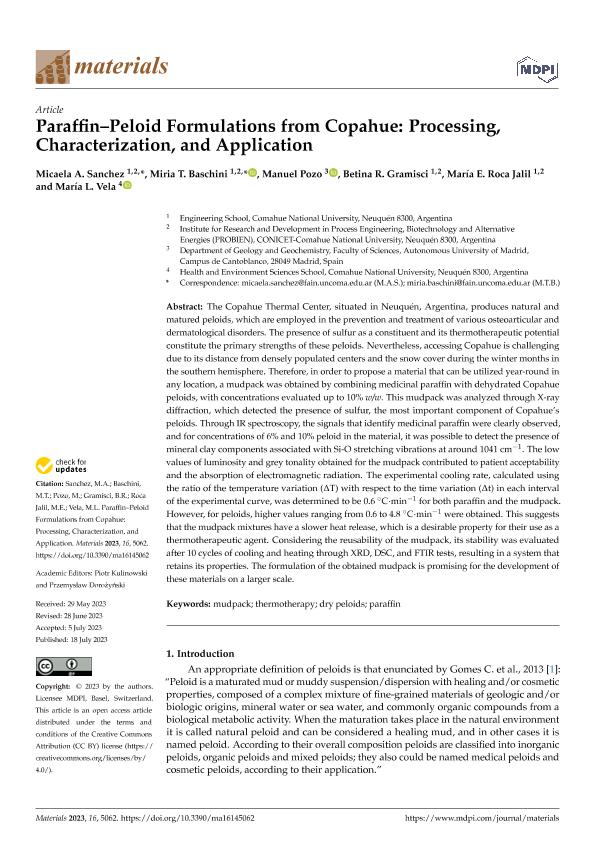Artículo
Paraffin–Peloid Formulations from Copahue: Processing, Characterization, and Application
Sanchez, Micaela Andrea ; Baschini, Miria Teresita; Pozo, Manuel; Gramisci, Betina Rocío
; Baschini, Miria Teresita; Pozo, Manuel; Gramisci, Betina Rocío ; Roca Jalil, María Eugenia; Vela, María L.
; Roca Jalil, María Eugenia; Vela, María L.
 ; Baschini, Miria Teresita; Pozo, Manuel; Gramisci, Betina Rocío
; Baschini, Miria Teresita; Pozo, Manuel; Gramisci, Betina Rocío ; Roca Jalil, María Eugenia; Vela, María L.
; Roca Jalil, María Eugenia; Vela, María L.
Fecha de publicación:
07/2023
Editorial:
MDPI
Revista:
Materials
ISSN:
1996-1944
Idioma:
Inglés
Tipo de recurso:
Artículo publicado
Clasificación temática:
Resumen
The Copahue Thermal Center, situated in Neuquén, Argentina, produces natural and matured peloids, which are employed in the prevention and treatment of various osteoarticular and dermatological disorders. The presence of sulfur as a constituent and its thermotherapeutic potential constitute the primary strengths of these peloids. Nevertheless, accessing Copahue is challenging due to its distance from densely populated centers and the snow cover during the winter months in the southern hemisphere. Therefore, in order to propose a material that can be utilized year-round in any location, a mudpack was obtained by combining medicinal paraffin with dehydrated Copahue peloids, with concentrations evaluated up to 10% w/w. This mudpack was analyzed through X-ray diffraction, which detected the presence of sulfur, the most important component of Copahue’s peloids. Through IR spectroscopy, the signals that identify medicinal paraffin were clearly observed, and for concentrations of 6% and 10% peloid in the material, it was possible to detect the presence of mineral clay components associated with Si-O stretching vibrations at around 1041 cm−1. The low values of luminosity and grey tonality obtained for the mudpack contributed to patient acceptability and the absorption of electromagnetic radiation. The experimental cooling rate, calculated using the ratio of the temperature variation (∆T) with respect to the time variation (∆t) in each interval of the experimental curve, was determined to be 0.6 °C·min−1 for both paraffin and the mudpack. However, for peloids, higher values ranging from 0.6 to 4.8 °C·min−1 were obtained. This suggests that the mudpack mixtures have a slower heat release, which is a desirable property for their use as a thermotherapeutic agent. Considering the reusability of the mudpack, its stability was evaluated after 10 cycles of cooling and heating through XRD, DSC, and FTIR tests, resulting in a system that retains its properties. The formulation of the obtained mudpack is promising for the development of these materials on a larger scale.
Palabras clave:
DRY PELOIDS
,
MUDPACK
,
PARAFFIN
,
THERMOTHERAPY
Archivos asociados
Licencia
Identificadores
Colecciones
Articulos(PROBIEN)
Articulos de INST. DE INVESTIGACION Y DES. EN ING. DE PROCESOS, BIOTECNOLOGIA Y ENERGIAS ALTERNATIVAS
Articulos de INST. DE INVESTIGACION Y DES. EN ING. DE PROCESOS, BIOTECNOLOGIA Y ENERGIAS ALTERNATIVAS
Citación
Sanchez, Micaela Andrea; Baschini, Miria Teresita; Pozo, Manuel; Gramisci, Betina Rocío; Roca Jalil, María Eugenia; et al.; Paraffin–Peloid Formulations from Copahue: Processing, Characterization, and Application; MDPI; Materials; 16; 14; 7-2023; 1-14
Compartir
Altmétricas



